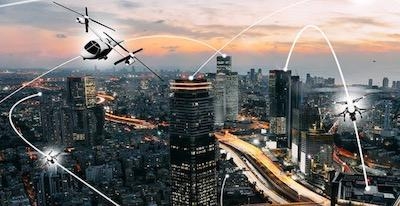Tests Centered On Computer Simulations Of Air Traffic Around The Dallas-Fort Worth Airport
A new future for city transport is in the works at NASA – a future where both people and packages will take to the air. And this week, the agency is working with partner company Uber to evaluate certain things we already know and others we still need to invent to manage this expected new air traffic. The goal, known as Urban Air Mobility, or UAM, is a safe and efficient air transportation system where everything from small package-delivery drones to passenger-carrying air taxis operate over populated areas – from small towns to the largest cities.

Researchers at NASA’s Ames and Langley Research Centers are developing technologies for UAM airspace management to make large-scale operations possible. At Ames, in California’s Silicon Valley, there's a good foundation to build on. Researchers here have already studied, designed and tested tools and technologies that could be used in the near future to manage the airspace for small drones flying at low altitudes, even in complex urban landscapes. Called Unmanned Aircraft Systems Traffic Management, or UTM, it’s giving a leg up to the emerging world of passengers and goods traveling smoothly above our city streets.
Under a partnership taking urban air mobility forward, Uber is sharing its plans for implementing an urban aviation rideshare network. NASA, as America’s aeronautics research agency, is using the latest in airspace management computer modeling and simulation to assess the impacts of small aircraft in crowded environments.
This week, the two are running tests focused on identifying the kinds of data and information necessary for UAM, where multiple operators of sometimes passenger-sized vehicles will need to fly safely together in the airspace. The teams at Ames and at Uber will connect their computer systems and run through different scenarios that UAM operators could encounter. One focuses on coordinating scheduling of different flights prior to takeoff, for example; another on coordinating different elements of an emergency landing situation.
There are no pilots, aircraft or air traffic controllers at these particular tests, which are centered on computer simulations of air traffic around the Dallas-Fort Worth airport. Instead of human participants, NASA and Uber will evaluate highly automated algorithms for managing city-going air vehicles in the airspace.
The evaluation will help the teams understand how to adapt the small-drone architecture and services of UTM for the new UAM operations, and what additional data the new system will need to provide. For example, NASA and Uber researchers found it was necessary to communicate the specific times when their respective UAM flights were expected to cross route intersection points and how much buffer around those times was needed to allow for unexpected events during flight.
One year ago at Ames, in September 2018, a UAM activity involving human users took place to test the foundation of this UAM airspace management system. Based on the success of that test, the system was matured to where it is today.
While this year’s evaluation test was with Uber, NASA intends to collaborate with many partners and ensure airspace operations will meet the needs of multiple use cases and be interoperable with the FAA’s systems.
With its partners, NASA will continue developing the UAM airspace system for NASA's UAM Grand Challenge. This is a series of activities aimed at putting relevant technology in development to use. The knowledge gained from these efforts will help prepare the many parties supporting Urban Air Mobility for a full field demonstration of vehicles and operators’ systems in an urban environment.
(Image provided with NASA news release)
 ANN's Daily Aero-Term (04.30.24): Runway Centerline Lighting
ANN's Daily Aero-Term (04.30.24): Runway Centerline Lighting ANN's Daily Aero-Linx (04.30.24)
ANN's Daily Aero-Linx (04.30.24) Airborne 04.24.24: INTEGRAL E, Elixir USA, M700 RVSM
Airborne 04.24.24: INTEGRAL E, Elixir USA, M700 RVSM Airborne 04.29.24: EAA B-25 Rides, Textron 2024, G700 Deliveries
Airborne 04.29.24: EAA B-25 Rides, Textron 2024, G700 Deliveries Airborne-NextGen 04.23.24: UAVOS UVH 170, magni650 Engine, World eVTOL Directory
Airborne-NextGen 04.23.24: UAVOS UVH 170, magni650 Engine, World eVTOL Directory



